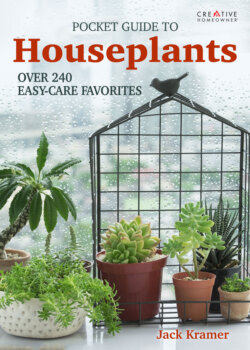Читать книгу Stitching Pathways - Jack Kramer - Страница 8
На сайте Литреса книга снята с продажи.
Use the Elements of Design
ОглавлениеAs with antiques and artwork, you will get the greatest impact from houseplants if you arrange them according to established aesthetic principles. Balance, proportion, and harmony are important. One houseplant in a room can look lonely and out of place, but a well-balanced grouping of three or five plants can become a synchronized team in harmony with its surroundings. Similarly, a five-foot dieffenbachia on one side of a room and a 5 in. (13 cm) begonia on the other side would be out of balance, but repeating these same plants together in other areas of the room can create a sense of rhythm and proportion.
Group Small Plants
Smaller plants gain visual impact when you group several together. When grouping plants, aim for a variety of sizes and a range of textures. Arrange the plants so the change in height or texture is gradual, rather than placing the smallest plant next to the tallest one or placing the boldest, coarsest plant next to one with the smallest, most delicate leaves. Also, try to create some depth. Set some pots in front and others in back instead of lining them up like a row of soldiers.
When grouping small plants, use different heights to promote interest. The poinsettia on the floor anchors the stage for the angel’s wings.
The flowering tuberous begonia is always elegant and looks at home atop this ornate table pedestal.
Use Single Plants as Focal Points
You can turn a favorite specimen into a focal point by displaying it on a stand or pedestal, or on a table or mantel. This will add a welcome burst of color. Houseplants can make dim corners inviting, especially when you place them in attractive ceramic containers or on stands. Orchids and gesneriads displayed this way are particularly breathtaking. In fact, they can be more striking than traditional cut flowers, and they usually last much longer.
Create Transitions
Another technique employs plants to create a transition between an indoor room and the outdoors. If you have sliding glass doors or a large bay window, place houseplants inside that resemble—or are related to—plants growing outdoors. In the Southwest, for example, an outdoor garden could be echoed by potted cacti and succulents indoors. In the Southeast, palms and gingers can create a continuous tropical feeling, both indoors and out.
Bring the outdoors inside with an arrangement of potted plants. The vertical cactus anchors the scene and adds drama, while the varied leaf shapes of the other plants provide eye-catching texture.
Correct plant placement, using balance, form, and texture, is represented in this living room. The fig tree in the corner sets the stage for the other plants, which accentuate, rather than compete with, the green upholstery.
